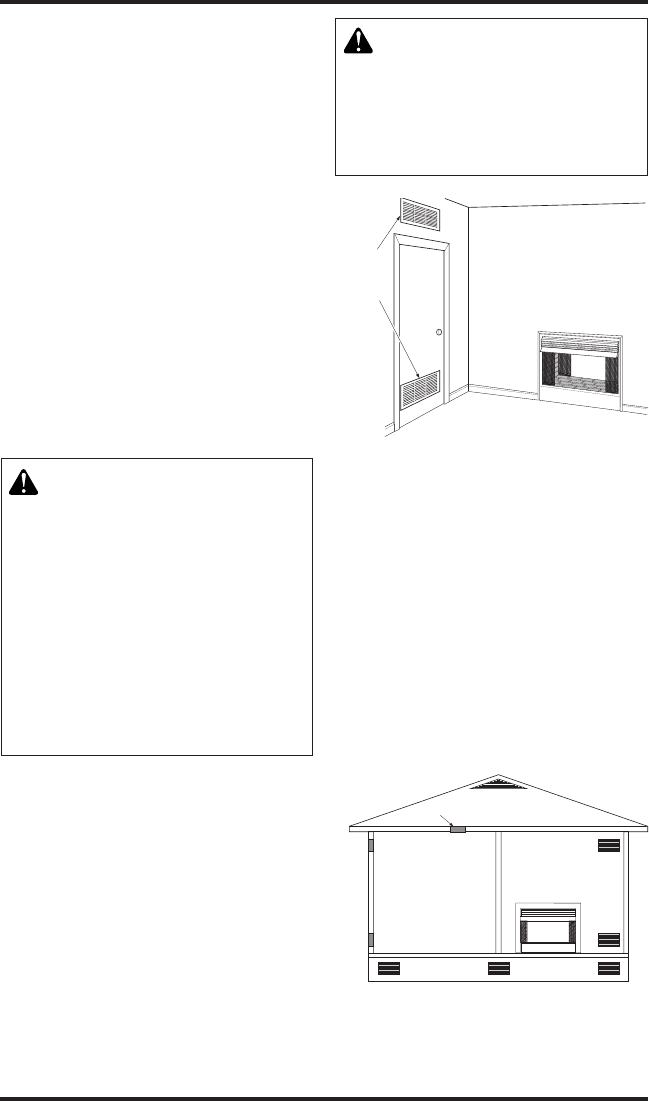
www.desatech.com
105116-01D 7
The space in the above example is a conned
space because the actual Btu/Hr used is more than
the maximum Btu/Hr the space can support. You
must provide additional fresh air. Your options
are as follows:
A. Rework work sheet, adding the space of an
adjoining room. If the extra space provides an
unconned space, remove door to adjoining
room or add ventilation grills between rooms.
See Ventilation Air from Inside Building.
B. Vent room directly to the outdoors. See Ven-
tilation Air from Outdoors.
C. Install a lower Btu/Hr gas log heater, if lower
Btu/Hr size makes room unconned.
If the actual Btu/Hr used is less than the maxi-
mum Btu/Hr the space can support, the space is
an unconned space. You will need no additional
fresh air ventilation.
WARNING: If the area in
whichthereboxandgaslog
heater may be operated is
smaller than that dened as
an unconnedspace orif the
building is of unusually tight
construction, provide adequate
combustionandventilationair
byoneofthemethodsdescribed
in the National Fuel Gas Code,
ANS Z223.1/NFPA 54, Section 5.3
or applicable local codes.
VENTILATION AIR
VentilationAirFromInsideBuilding
This fresh air would come from an adjoining un-
conned space. When ventilating to an adjoining
unconned space, you must provide two perma-
nent openings: one within 12" of the ceiling and
one within 12" of the oor on the wall connecting
the two spaces (see option 1, Figure 3). You can
also remove door into adjoining room (see op-
tion 2, Figure 3). Follow the National Fuel Gas
Code ANS Z223.1/NFPA 54, Section 5.3, Air for
Combustion and Ventilation for required size of
ventilation grills or ducts.
AIR FOR COMBUSTION
AND VENTILATION
Continued
WARNING: Rework work-
sheet, adding the space of the
adjoiningunconnedspace.The
combined spaces must have
enough fresh air to supply all
appliances in both spaces.
Figure 3 - Ventilation Air from Inside
Building
Or
Remove
Door into
Adjoining
Room,
Option
2
Ventilation
Grills
Into Adjoining
Room,
Option 1
VentilationAirFromOutdoors
Provide extra fresh air by using ventilation grills or
ducts. You must provide two permanent openings:
one within 12" of the ceiling and one within 12"
of the oor. Connect these items directly to the
outdoors or spaces open to the outdoors. These
spaces include attics and crawl spaces. Follow the
National Fuel Gas Code ANS Z223.1/NFPA 54,
Section 5.3, Air for Combustion and Ventilation for
required size of ventilation grills or ducts.
IMPORTANT: Do not provide openings for inlet
or outlet air into attic if attic has a thermostat-
controlled power vent. Heated air entering the attic
will activate the power vent.
Figure 4 - Ventilation Air from Outdoors
Outlet
Air
Ventilated
Attic
Outlet
ir
Inlet
Air
Inlet Air
Ventilated
Crawl Space
To
Crawl
Space
To Attic
